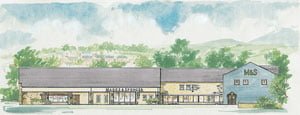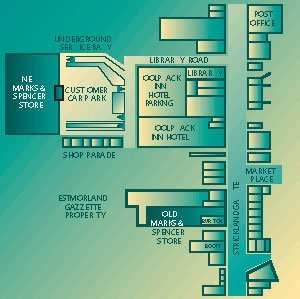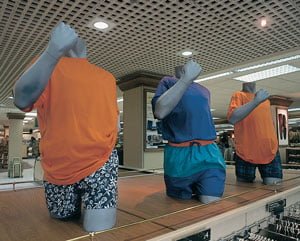This case study describes the relocation in 1994 of the Marks & Spencer store in Kendal. The situation presented is a relatively unusual example of store development for the company – not just because it involves a relocation, but because it involves the acquisition and refitting of an existing supermarket.
Marks & Spencer is committed to offering its customers high quality products and an efficient service in attractive and comfortable surroundings – this requires an on-going store development programme involving expansion and modernisation. Store development projects not only include the building of new stores on greenfield sites, but also modernising and extending the footage of existing stores, and relocating others to more appropriate sites. Relocations are rare, however, as the majority of Marks & Spencer stores are already in prime retail locations.
Getting the planning and co-ordination right
Relocation projects are driven by the desire to improve Marks & Spencer’s profitability, by enhancing either the convenience of a store’s location or the store environment, to better satisfy customer needs. When relocating, a considerable amount of time, resources, research, planning and management effort will be invested. Many individuals and departments within the business will be involved and a number of external organisations will contribute – all working to achieve the company’s objectives.

The date is January 10th 1994. Marks & Spencer is six-months into the schedule for a store relocation project in Kendal, Cumbria. In the text below we hear from three key managers closely involved in the scheme. Paul Mellor is the Kendal Store Manager, Mike Peterson is Technical Co-Ordinator for Construction Services in the Store Development Group and Katy Bull is Store Planner for the project. Their comments provide an insight into the reasons for the relocation, how the project is progressing and the tasks still to be carried out prior to the new store opening.
Why relocate?

Paul explains some of the background to the project. “Kendal is a busy market town in Cumbria on the south-eastern edge of the Lake District National Park, which is a popular tourist area. The town is close to the M6 motorway and about 25 miles north of Lancaster. The map shows our current store in Kendal at 18-20 Stricklandgate.
It’s a prime location in the High Street, where we are at the heart of shopping activity and we pick up a lot of passing trade. However, there are a number of problems with the site. The selling space, at 9000 sq. ft, is far too small to exploit the sales potential available in Kendal – the sales per square foot performances we’re achieving clearly show we can support a far larger store. The narrow frontage doesn’t reflect the offer behind the doors, and the long narrow shape of the store and bottle-neck entrance don’t help either when you’re trying to create exciting merchandising. A worse problem is access to the rear of the store for deliveries – our lorries struggle to get down the narrow access roads and we pay a substantial rent for access rights across private land to get to our loading bay.”
“Last August the company decided it really must sort out the Kendal situation once and for all and relocation became the only real option. In 1993, I heard Fine-Food were under pressure from local competition and our acquisitions people in the Estates Department started seriously considering this site as an option. It is an unusual relocation choice, because we are effectively vacating a prime High Street site for a site that is off-pitch in terms of passing footfall and has to attract customers in its own right.”
“However, the site does have a number of significant advantages. For a start, it is the ideal footage we want, with the sales area all on one floor in a very workable footprint – which should lead to a significantly increased turnover but with proportionately less staff and management. The new site has a large car park (160 spaces, although 70 of these are underground) which is ideal for food shoppers. Access for deliveries is excellent, with a dedicated entrance and purpose-built underground delivery area.”
Project management
Mike explains his role in the project. “Because the Kendal scheme is relatively small, I have been delegated much of the project management responsibility on the construction side. My job is to ensure all the necessary building and fitting-out work is completed on time, within the costs that have been agreed and to the right specification.”
Katy explains her role as Store Planner for the project. “ We focus on ensuring new stores are designed in a way that meets the commercial requirements of the business, maximise sales in an attractive store environment and ensure stores are operationally efficient to minimise costs. I liaise with all departments that have an interest in the design, building and operation of the store. I must ensure that the final layout meets the needs of the Store Manager, Divisional Management and also the Buying Groups – they are my clients. My brief therefore covers a range of layout and design issues – looking at the way stock is moved around the store, positioning walkways to facilitate customer movement around the store, positioning fixtures such as food counters, fridges, tills and displays and deciding the width of gangways.”
“I will also get involved later in the project to plan the loose merchandising equipment (racks etc.). We need to know what we’re doing on these things about 12 weeks before opening, because it can take so long sometimes to order some of the equipment.”
Research

Paul explains, “In the case of Kendal, the whole process really got underway once the Estates Department had kicked off serious interest in the Fine-Food site on 9th August 1993. I was involved from the beginning when we were doing the feasibility research, arguing vigorously in favour of the resite. A lot of research went into estimating the turnover and a host of factors were considered – existing sales performances, the proposed selling space available, the local customer profile, the size of the catchment population, local competition and so on. ”
Mike has been closely involved in the planning activities at Head Office and he picks up the story. “At the start of September we then went through to the preparatory planning stage, during which the scheme was subjected to progressively more and more detailed examination and had to pass through a series of Project Boards before it could gain approval to proceed to the Capital Evaluation Committee (CEC) in early November. The preparatory planning stage started with probably a month’s work by a skeleton design team drawing up a broad outline of the proposed scheme. Once this had been agreed by the Project Board, we then studied the scheme in detail.
Our Architects, Corporate Designers and Store Planner produced detailed plans and layouts, even down to walkways and the location and size of the main sales departments. We needed detailed layouts at this stage because of the implications for costs and plant requirements. Once the final Project Board was happy with these we could then go to the CEC for approval for the funds and the go-ahead.”
“After the initial feasibility research in August, we went into negotiations with Fine-Food and we had to do the background planning in strict confidence. We had to be careful not to spark off any rumours of our interest in the site, which might upset the existing Fine-Food staff, until everything had been settled.”
“The project was approved by the Capital Evaluation Committee within a couple of weeks. All the research showed the Kendal scheme would achieve the required returns, so the Directors gave us the okay on the expenditure without a problem. As soon as we had approval we went to tender on the design and build contract for the store.”
Paul Mellor has also been involved throughout the planning process. “I’m making sure that I have an input on the internal design of the store, because of my commercial management interest. The sales floor plan is mainly developed by Store Planning, who work to a successful design formula. Throughout the preparatory planning stages, I fed in my views on the location and sizes of departments and on the positioning of customer service desks, tills, telephones and so on. I also want a canopy over the entrance – it rains so much in Kendal I can see staff getting very wet whilst they open with their bags to get through the card swipe.”
Planning

Mike explains how the building work is likely to develop over the next few weeks and the current position on planning approvals. “The building contractor will have access to the site from 14th February and within a fortnight there will be scenes of organised chaos, peppered with hoardings, huts and hard hats. The building contractor will spend two weeks or so preparing the site and then two weeks stripping the building and putting in the new roof insulation. Then work can begin in earnest on the installation of new sprinkler, electrical and mechanical services and the new lift.”
“It takes time to get all the necessary permissions, because some of the process requires statutory public notice periods to see if anyone has any objections. The main things we’re seeking approval for are changes to the elevations and shop-front (moving from a 60’s Swiss chalet-look to a 90’s rustic-look, and relocating the entrances), new directional signs on Library Road and new signs on the front of the store and of course we’ll need building regulations approval.”
The Building and Fitting-Out Process
“The main objective for the building contractor will be to open as soon as possible. We’ll confirm the exact opening date once we’ve been on site a few weeks and we’ll have progress meetings every 4 weeks anyway to make sure things are going to plan.”
“We’ve got to fit-out three levels of the building (see diagram above) – the lower ground floor (underground car park, stockroom, refrigeration plant area and goods reception area), the ground floor (sales area, food hall and backstage areas including the cold room) and the mezzanine floor (kitchen, toilets, offices and EPOS room).”
“The ground floor fit-out will take place in three stages. It will take a week to install the high-level electrical, mechanical and sprinkler services above the sales floor and foodhall and fix up the ceiling grid ready for the ceiling tiles to be added later. The CCTV equipment will be installed as soon as the electrical work is finished. After that we can start putting in some of the Marks & Spencer design features like perimeter panelling, trims, skirting, coving, cornice and isometric lighting, which will take 5 weeks. Once these are sorted, we can get the vinyl flooring down in the foodhall, the carpets down on the rest of the sales floor, drop the ceiling tiles into place and put the doors on. We can then install the equipment – for the fitting rooms, the Marks & Spencer Financial Services desk area, the Customer Service Desk, the wall and mid-flooring merchandising equipment, food cases and shelving, till podia, tills and phones. This flooring and equipment stage will take about 5 weeks. The lobby area and the automatic doors on the shop-front will be left quite late so we can get some of the larger equipment (particularly the refrigeration plant) into the store more easily. The sales floor needs to be handed over to the Store Manager two weeks before opening, to give staff enough time for dressing.”
“Backstage we need to get the cold room fully operational and down to the correct temperature in time for handover four weeks before opening.”
“On the mezzanine floor we need to fit out staff quarters. We’ll need 7 weeks to sort the basic services and joinery for the offices, kitchen and toilets and then probably 4 weeks to decorate, put the vinyl flooring and carpets down, do the final clean and take in the office furniture and kitchen equipment. We should be ready to hand over the staff quarters 3 weeks before the opening.”
“On the lower ground floor we’ve got some general improvement works in the car parking area and preparation of the stockroom and goods reception areas (including upgrading the dock-leveller/hoist and shutters), which will probably take 9 weeks.”
“In addition to all the fitting-out work, we’ve also got to get all the major equipment commissioned, of course, which means checking and testing the sprinklers, air conditioning, refrigeration plant, alarms and so on, to ensure everything works the way it should. All the IT gear will be dry-run and various tests done to make sure you can communicate and that the data checks out and all the tills will be tested once they’re hooked up. Then there’s the outside of the building – trolley corals, minor improvements to the layout of the car park and new white lining and signs.”
Objectives

Paul is not sure yet when his new store might open. “In the early days of considering the Fine-Food site, I favoured Easter for the opening or certainly no later than the spring bank holiday at the end of May, all of which are classic times to open – particularly Easter because not only is it a peak in itself, but it is also a good opportunity then to hit the kind of merchandise which sells well between Easter and Summer. The later you leave it, the less window you have. Similarly if you open in the Autumn, you are set through to Christmas. The other issue with opening dates, however, is that, while we want to open as soon as possible from a commercial trading point of view, the last thing we want to do is rush it and risk things going wrong.”
Paul explains his role and objectives in the project. “Apart from my input on the layout of the store, my role will really come to the fore in the last 10 or 12 weeks before opening. Once we get underway my objective will be to close the old store down successfully, as well as to open the new store, with minimal disruption to trade or damage to the image of Marks & Spencer in Kendal. I’ll want to close the old store at the normal time on the chosen Saturday and open the new store on the following Monday morning.”
According to Mike, “I’ll want to keep in contact with the building contractor’s Site Manager, to keep tabs on how things are going and to learn as much as possible about what is going into my new store. I can also then keep my staff up-to-date on progress – it’s important to build your staff up to the big opening day. I will also need to keep in close contact with our Head Office managers responsible for IT systems, buying, transport and corporate affairs, who will get more and more involved in the project as we get nearer to opening. I’ll also have to maintain close and cordial relationships with various local authorities, organisations and groups, partly to promote the scheme and keep them informed of progress, but also to make sure we’re meeting the needs of the local community.”
“I’ll need to get involved in planning the promotional activities to publicise and support the opening. Our Corporate Affairs Group organises most of the promotions work for the opening of a new store, but we can influence the type of campaign and feed in our knowledge of the best local press and media to use. We’ve got an excellent local commercial radio station ‘The Bay’, which covers our catchment area, so we will definitely use that and we’ll look at the local papers, posters and other media possibilities with Head Office. As soon as we’ve confirmed the definite opening date we can lock into the promotions schedule which will focus on the critical four weeks before launch day.”
Conclusion
The store relocation at Kendal had a positive impact upon Kendal as a town. No trade was lost and the dressing of the store was managed without disruption. A year after the opening of the new store there has been considerable investment in the town’s retail provision, with new retail developments close to the Marks & Spencer site. The new store helped to provide this change of focus for the town.
